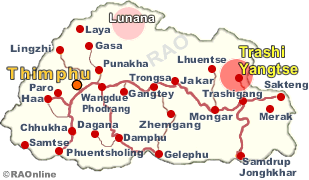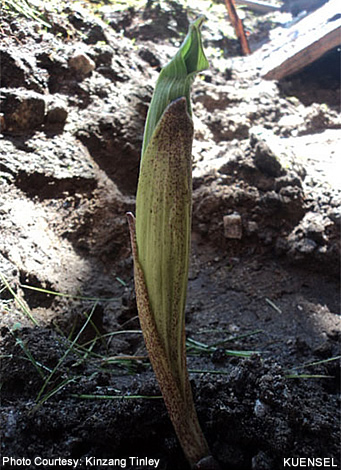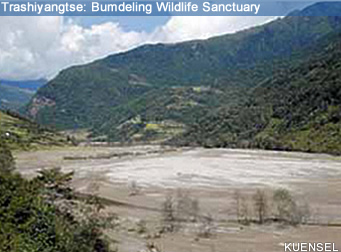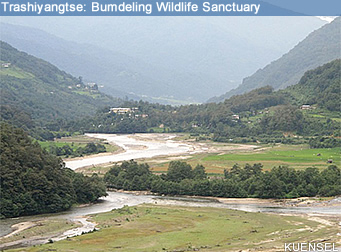 |
Bhutan's Nature National Parks |
|
 |
Bhutan Information |
|
|
 |
| Bhutan's
National Parks, Wildlife Sanctuaries and Nature Reserves |
 |
| Bumdeling
Wildlife Sanctuary |
 |
Deyma Plant - This wild alpine plant serves as a handy substitute for the greens that don't grow there
 |
If you visit Khoma in the eastern district of Lhuentse at this time of the year, you'd most likely end up eating a wild alpine flowering plant locally known as deyma.
The bitter tasting plant is used as a vegetable and cooked with meat, potato or radish, and served as a side dish with rice, when other greens are scarce during winter. |
|
Karma of Rongmateng village in Khoma has in stock about 10kg of the dried alpine plant, scientifically known as Smilacina pupurea, for winter consumption.
Every summer, the father of six, who is in his 40s, walks an hour and a half from his house to gather deyma from the forest, when it is still a young shoot and has not yet flowered.
"No matter how much you harvest in a season, deyma grows abundantly in the following seasons," Karma said. "Since we can't grow enough vegetables, like in other parts of the dzongkhag, we are dependent on deyma," he said.
 |
| Good enough to be eaten: A deyma shoot in Rongmateng |
An elder from the village said they never cultivated deyma in their kitchen gardens. "In summer, we face problems drying, when there's heavy usual rainfall," he said.
Villagers said consuming deyma is an age-old tradition for the Rongmatengpas, who also consumed some varieties of wild mushroom in summer.
Villagers said deyma grew in rocky areas, together with shrubs and grasses. "It tastes like spinach, but is bitter," a villager said.
Karma said the plant is shred into thin strips and dried in the sun. "Dried deyma should be soaked and rinsed in hot water before cooking to reduce its bitter taste," he said.
Some nature conservationists have however raised concerns over the mass collection of the plant. |
|
"I've seen people collecting deyma in the village while on border patrol during the last cordyceps collection season," park ranger of the Bumdeling wildlife sanctuary (Khoma office), Kinzang Thinley, said. "One of the suggestions could be to encourage the highlanders to cultivate the plant in the vicinity of their village.
An earlier study by the park has shown that exponential growth in population has led to overwhelming pressure on natural resources.Destructive harvesting techniques were used to collect deyma, where plant parts, such as young shoot, bark, stems and whole plant, are extracted.
But villagers claimed that they cut the shoots and the roots were left behind, from which new shoots regenerate in the next season.
The 2003 study on the sustainability of non-wood forest products in BWS indicated that medicinal plants, such as picrorhiza, cordyceps, nardostachys and smilacina plant, because of its vegetable value, are over-collected and long-term sustainability is uncertain.
Smilacina is a beautiful perennial plant found to be growing in alpine areas within the altitude of 3200-4000masl.
The plant is known to grow up to height of 70cm with dark green, red-margined foliage.It flowers in May-June and the seeds ripen in August-September.The flowers are hermaphrodite and pollinated by insects.
Deymas are found in the alpine areas of western China, Nepal, Bhutan, and in other parts of Asia in the eastern Himalayas. In Bhutan, this perennial plant is mostly found in the temperate conifer forest in the northern parts of the country.
 |
| Source: By Nima Wangdi, KUENSEL, Bhutan's National Newspaper 2013 |
top
| Wildlife and People in Bhutan |
 |
| Information on Bhutan |
 |
|






